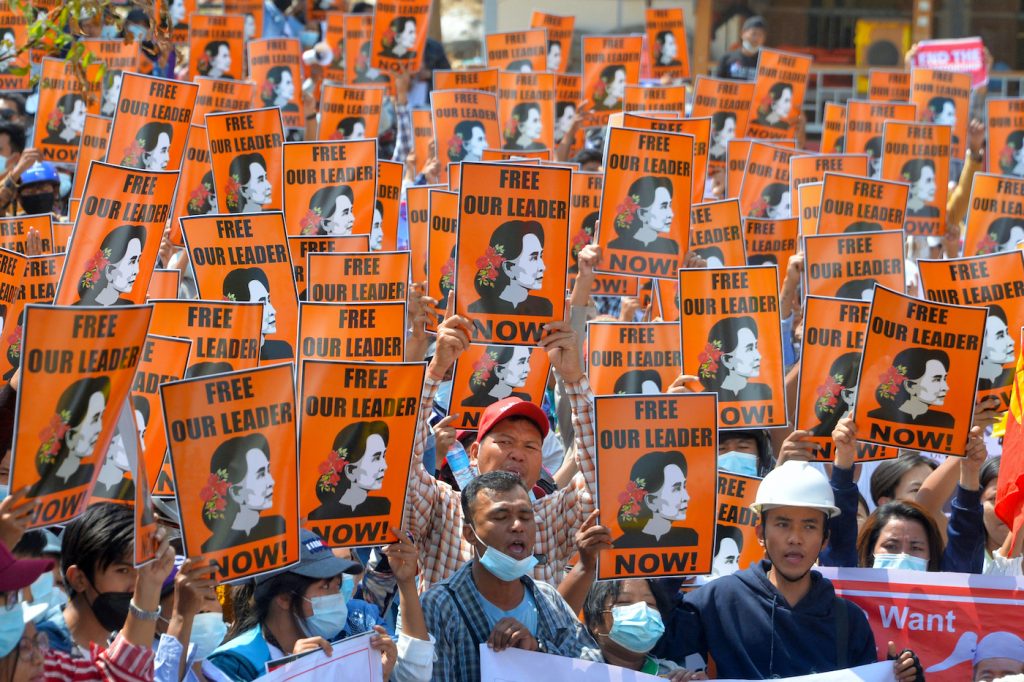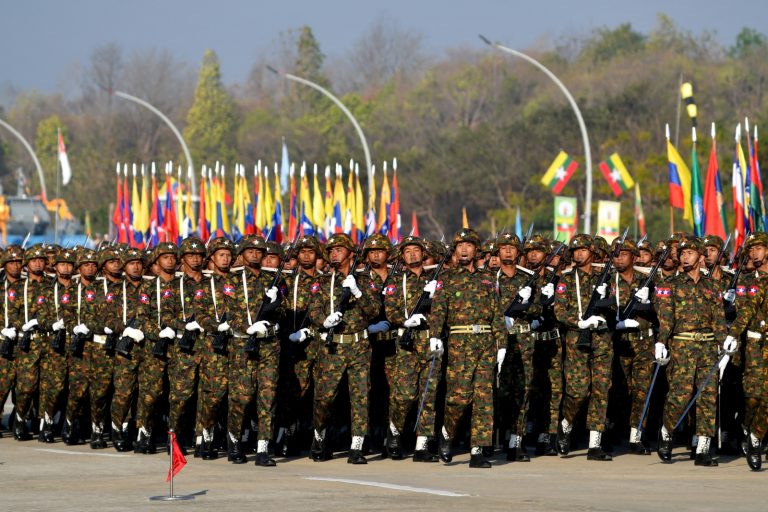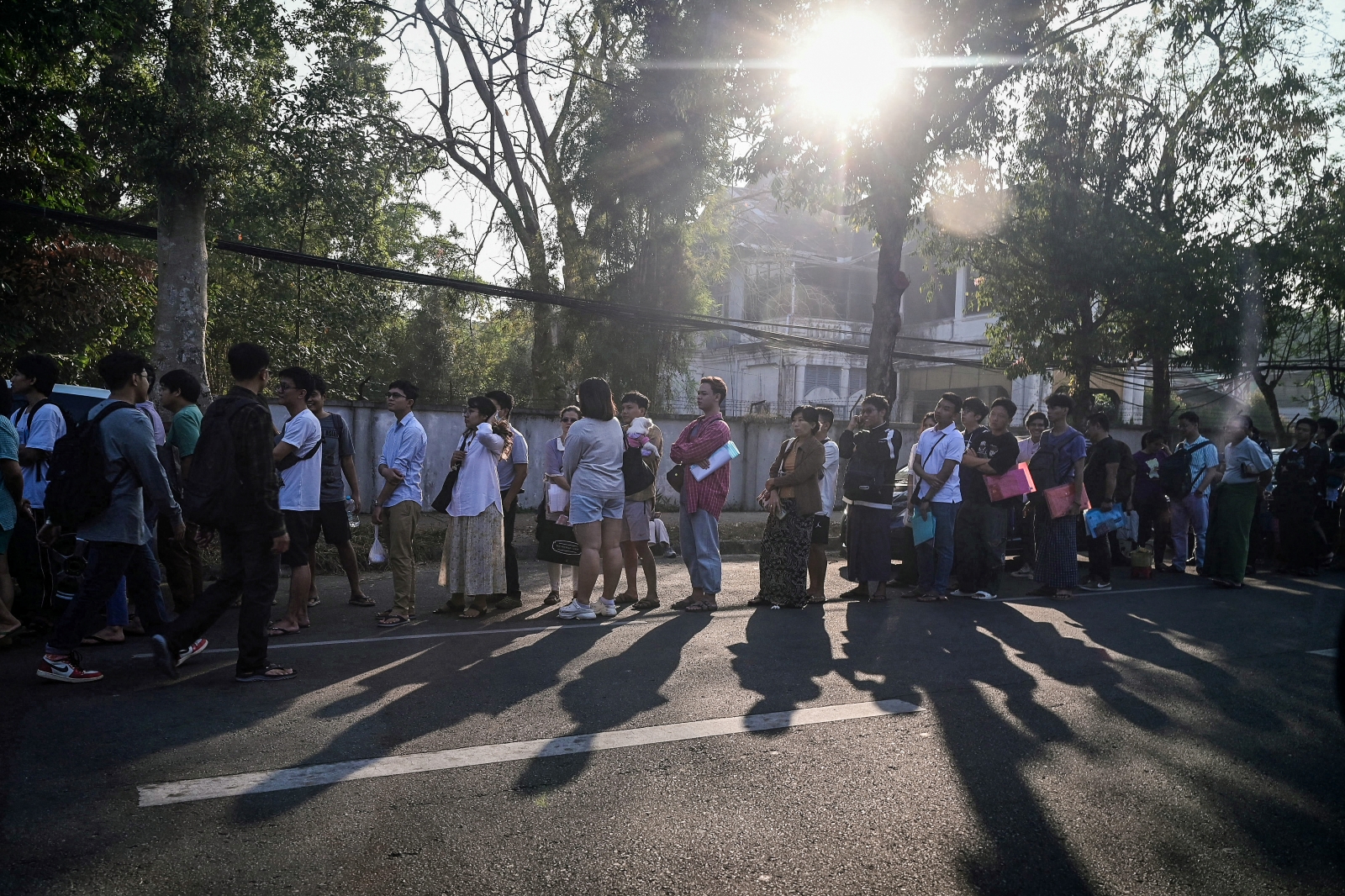Ruthless crackdowns, including mass arrests, have largely quelled protests in Myanmar’s capital, but the regime has struggled to crush the spirit of the Civil Disobedience Movement despite prosecuting leading members.
By FRONTIER
When anti-military protests erupted in the wake of the February 1 coup, few areas of the country remained silent.
Even in the administrative capital Nay Pyi Taw – purpose-built, in part, to insulate the military from popular uprisings – tens of thousands joined mass demonstrations.
The Thapyaygone roundabout in Zabuthiri Township became a focal point for demonstrations, with protesters rallying around the junction’s Bogyoke Aung San statue.
On February 9, security forces opened fire there, shooting 19-year-old Ma Mya Thwe Thwe Khine in the head. For ten days the teenager clung to life at a Nay Pyi Taw hospital. On February 19, Mya Thwe Thwe Khine died, becoming the anti-coup movement’s first martyr.
Since then, the military and police have ruthlessly, murderously cracked down on demonstrations across the country, with the Assistance Association for Political Prisoners estimating they have so far killed more than 730.
But before the deadly crackdowns got underway elsewhere, security forces had long before quelled protests in Nay Pyi Taw.
An uneasy calm now prevails, with residents telling Frontier that an overwhelming military presence and the constant fear of arrest have worked to keep opposition in check.
Mass arrests begin
The round-ups began on February 18, as Mya Thwe Thwe Khine still clung to life. Police arrested at least 10 people and confiscated dozens of cars and motorbikes that, more than two months later, have still not been returned.
In the following days, security forces stepped up enforcement of restrictions on gatherings of five or more people. When tens of thousands gathered at the hnin si (rose) roundabout in Pyinmana for the nationwide 22222 uprising, security forces broke up the gathering with live rounds.
Junta forces even silenced the 8pm banging of pots and pans – a nightly ritual throughout the rest of the country – by firing live rounds into the air to terrorise residents in two Zabuthiri wards on February 25, then did it again in an adjacent ward the next night. A resident there told Frontier the ritual has largely quieted since.
Demonstrators quickly changed tactics. When another nationwide call to protest went out for February 28, activists in Nay Pyi Taw chose less prominent locations that were more difficult for police and soldiers to reach.
But even these small shows of dissent have largely disappeared. When small groups of mostly young people march even through isolated wards and quarters, security forces are quick to respond and make arrests, residents say.
Nearly 300 people were arrested at protests in the second half of February. While most were later released, several deemed protest leaders and participants in the Civil Disobedience Movement remain in custody and are facing various charges.
U Tun Hmwe, a Nay Pyi Taw resident, said authorities have yet to release his son, who is in his early 20s. His son, who he declined to name for security reasons, was arrested along with 36 others at a demonstration on March 15 that brought more than 100 people onto the streets; he and another participant about the same age as him remain in custody, suspected of “leading” the demonstration. Tun Hmwe said his son may have urged his friends to join, but he was no activist or organiser.
His son has been charged with violating COVID-19-related bans on large gatherings under section 25 of the 2013 Natural Disaster Management Law, which carries a maximum three-year sentence.
Police have not returned the hundreds of cars, motorbikes, mobile phones and other personal items they’ve seized from protesters, residents say. Rumours abound, on social media and elsewhere, that police will return seized property if bribed, but claimants that Frontier spoke to say they don’t know where to go or who to bribe.
A Pyinmana man whose motorbike was seized during a February 22 protest said he had been variously told by neighbours that his property could be returned for a payment of K30,000, K50,000 or K100,000.
“But you don’t know for sure where to go. When you do ask, they just pass the buck. Lawyers have promised to make enquiries but have said nothing yet,” he said.
Crushing the CDM
As the centre of government, Nay Pyi Taw has been a focal point for the CDM. Although there is no accurate or complete tally of striking public servants in Nay Pyi Taw, a member of the CDM Support Team there estimated that about 3,400 people across virtually every ministry have have enrolled for support since walking off the job, but the total number who’ve joined the CDM in the capital is believed to be far higher than that.
Civil servants who joined the CDM began protesting in early February at junctions surrounding Zabuthiri’s Myoma Market, which many government workers pass on the way to their offices. But after a prisoner transport truck was permanently stationed there in the beginning of March, protests shrank to vanishing.
Still, striking civil servants say more government employees are joining the CDM in Nay Pyi Taw. Some have gone into hiding or returned to their hometowns for fear of arrest, which has also contributed to the dwindling visibility of the resistance in the capital.
The authorities have used an array of tactics to try and coerce civil servants back to work. Some have been forcibly evicted from their staff housing by soldiers. Spouses of striking civil servants who also work for the government have faced demotion or termination. Frontier spoke to one Ministry of Social Welfare, Relief and Resettlement employee who joined the CDM and saw his wife, who also works at the welfare ministry, demoted. He said that despite the retribution against his wife, he will continue in the CDM.
Others are facing legal action. Social media posts from parliamentary staff suggest at least 48 Pyidaungsu Hluttaw Office employees, 18 Amyotha Hluttaw Office employees and 17 staffers at the Pyithu Hluttaw Office have been suspended for breaching the Civil Service Law by joining the CDM.
A female Pyidaungsu Hluttaw Office employee told Frontier on March 20 that more than 90 have joined from her office.
Frontier could not verify this figure, but did speak with one participant from the office who said authorities have suspended anyone who joined the movement before February 15, and that those who have joined since have not yet been suspended but have been urged to return to work.
Another staffer who joined the CDM in early February and was suspended said she will never return “until the people’s government is back in power”, because the hluttaw is “where the people’s hopes are implemented”.
She estimated the three offices had more than 1,000 staff before the coup.
In the Ministry of Foreign Affairs, 11 employees have been charged under sections 505-A and 505(b) of the Penal Code with incitement for joining the CDM.
On March 11, eight employees in the Ministry of Agriculture, Livestock and Irrigation’s Cooperative Department were convicted of disobeying an order from a public servant under section 188 of the Penal Code for joining the CDM and sentenced to three months’ imprisonment.
The CRPH, comprised of ousted elected lawmakers and acting as a parallel government in opposition to the military, has said all military council orders are unlawful, and that striking civil servants do not have to obey them. The committee has also pledged to compensate civil servants who have joined the CDM, and will honour their sacrifices when a new, elected government takes power.
The decision to join the CDM remains the main form of protest in Myanmar’s political power centre.
One Zabuthiri man who was active in the early protests at the Thapyaygone roundabout said people in his township don’t dare demonstrate anymore. Occasionally in Pyinmana, he said, some “flash” protests – lasting no more than 20 or 30 minutes – still pop up, with demonstrators dispersing before police can arrive, but even they are growing rare.
A Pyinmana man said people have prioritised ways of dissenting that avoid security force crackdowns.
“We still have protest rides on motorbikes, but not as many as before, [and we] avoid confrontations with the police,” the young man said.
By the second half of March, police had removed the last of the pro-democracy and anti-military signs and posterboards that still remained scattered along Nay Pyi Taw’s roadways – the last physical indications of a populace in revolt.
But while the familiar quiet of the purpose-built capital has returned, the police trucks and prisoner transport vehicles permanently stationed at once-popular protest sites throughout town belie the appearance of peace.







